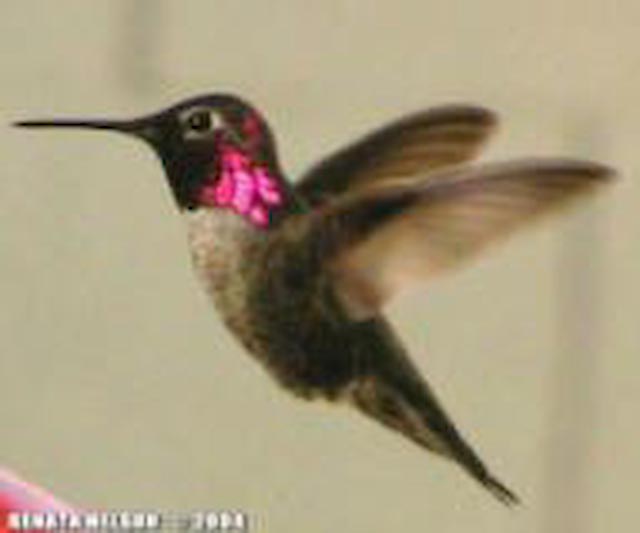Wildlife Rehabilitation
|
You’ve found an orphaned, sick, or injured animal and don’t know what to do. 1. Don't leave the animal on the ground if it can't move. It is defenseless against cats, dogs, predator birds and ants. The Arizona sun is also dehydrating. 2. Put the animal in a safe, covered containment such as a cardboard box or pet carrier lined with an old towel or paper towels. 3. Sick and/or injured animals can't regulate their body temperature and need to be kept warm with a heat source such as a heating pad or hot water bottle. You can fill an empty plastic milk jug, disposable water bottle or OJ container with hot water from the faucet. Put the lid back on. Put the container next to the animal or next to the box it's in. Putting the animal in a warm room or in a blanket does not work; the animal needs to be next to something that is radiating heat. Putting the animal outside does not work; the sun and dry humidity will dehydrate it. 4. An animal needs to be warm before it can accept water. Once it is alert, put drops of water along the outside of the beak or mouth. Don't force water down the animal's throat. An animal needs to be hydrated before it can accept food. Do not try to feed the animal until you talk to a rehabilitator. 5. Do not put ducklings in water. They also need to stay warm and dry. 6. Please note that older wild birds show stress by becoming very still and quiet. People often interpret this as "the bird knows I am trying to help it"; but in reality, the bird is in extreme stress. Prey animals (animals that are preyed on by predator animals...including humans) think they are going to die. Don't handle juvenile or adult birds any more than necessary. Don't pet the bird as you will be causing it fear. While baby birds just want someone to feed them, the older birds need dark, quiet containment away from people and pets.
Reminders: When calling to find a rehabber, have paper and pencil handy, as you will reach a recording that gives a list of names and phone numbers for you to call depending on the type of wildlife you have found and the area where you live. Volunteers working out of their own homes and at their own expense, plus they are often juggling work and family along with rehabilitating wildlife. Your patience and understanding are always appreciated. It is important for you to get the injured wildlife to the rehabber--unless other arrangements can be made-- it is impossible for the rehabber to leave the wildlife already in their care unattended.  Contact East Valley Wildlife at 480-814-9339 or
EastValleywildlife@gmail.com
Contact East Valley Wildlife at 480-814-9339 or
EastValleywildlife@gmail.com
If you cannot identify the animal, send a photograph to EastValleywildlife@gmail.com |
||
| . |

|
Birds have a limited sense of smell so detecting human scent is not an issue. |
Here are some common but difficult babies to identify.
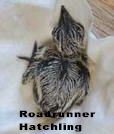
|

|
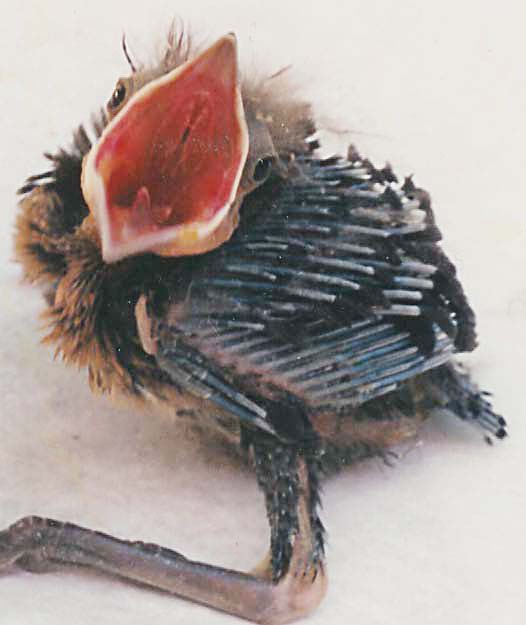
|
|
You may find these information sheets helpful (.pdf format):
Finch/Sparrow Comparison (being revised) |
|
A baby bird can be returned to the nest without problem if the baby isn't cold, sick, or injured...
and you return him to the right nest!
What is the most important thing to check for when finding a baby bird?
Make sure he is warm and alert!
| Renesting A Baby Bird | |
| Certain birds can be renested easier than others. Doves have the best chance of being renested but grackle kids should always be rescued. Adult grackles will call out the entire Grackle National Guard to scream at anyone who comes close to a fallen youngster but they have little interest in taking care of a baby on the ground. Sometimes the parent bird is trying to care for the baby on the ground but that can be dangerous because of predators. Getting the baby back to the nest is the ideal solution if the parents are still around. If the nest is destroyed, a natural fiber basket filled with dried grass will also work if hung in a protected place. Think "nest size" when making a selection...no laundry baskets, please. Plus the nest needs drainage in case it rains so plastic containers and cardboard boxes will not work. Also consider the protection the nest needs...it may look like a shady spot but will the afternoon sun hit it directly and bake the baby inside? Wire or tie the nest to the branch so it won't blow out again during the next wind storm. Watch from a distance to make sure the parent returns to care for the baby. If the baby is very young and alone after dark, it needs to be rescued. |
|
| If the Baby is an Orphan | |||
|
If the bird appears to be an orphan and cannot move around well, pick it up off the ground before cats, dogs, kids, hawks, grackles, or ants attack it. If you can pick the bird up easily, it's either injured or too young to be out of the nest and it does need to be rescued.
Keep all orphaned and injured wildlife warm with a heat source even in the middle of summer!
|
||
| Precocial Babies (covered with down and capable of moving about when hatched) | |

|
Precocial baby birds take longer to hatch but once they do, they're ready to follow mom (and sometimes dad) away from the nest. They can walk, swim (ducklings), and eat on their own. They're covered with soft down but still need to huddle under their parents for warmth for at least the first week. |
| Quail and Killdeer | |
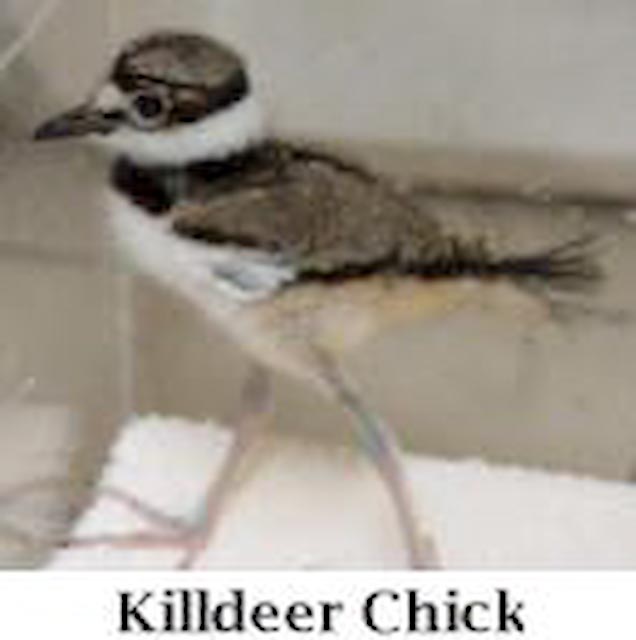
|
These babies are very fragile...do not handle any more then necessary. They also eat on their own...do not try to force food or water into their mouths. Keep extra warm (heating pad on medium). Finely crumble a hard boiled egg or shave the top of a broccoli floret for temporary food. Water needs to be in a SMALL jar lid with pebbles on the bottom; when these birds get wet, they crash fast. |
 |
Stress is the Number One killer of wildlife... keep all rescued birds in a warm, dark place in secure containment away from people, pets, and household noise. |
 |
Nestlings If you find a healthy nestling recently fallen from a nest (the bird
isn't cold, injured, or lethargic) the bird can be replaced in the
nest. It must be placed back into the right nest, however, or the
parents will reject it.
If you find a healthy nestling recently fallen from a nest (the bird
isn't cold, injured, or lethargic) the bird can be replaced in the
nest. It must be placed back into the right nest, however, or the
parents will reject it. If the nest has been destroyed, a substitute nest can be made from a small woven basket or plastic berry basket lined with dry grass (the container must have drainage). Wire the basket back to the tree in an area as close to the original nest site as possible and the parent bird should continue to care for her offspring. Watch the nest carefully over the next few hours to make sure the parent bird has found the new nest. If the baby bird is cold, injured or cannot be returned to its nest, it must be rescued. |
Fledglings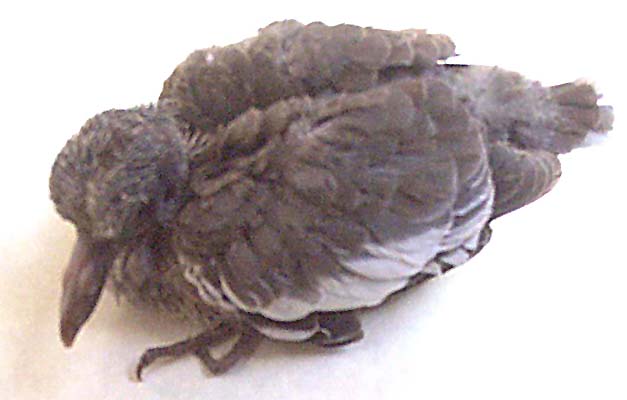 Older baby birds who are starting to leave the nest and learning to
fly may wind up on the ground and don't yet have the capability to
get back up into a tree.
Older baby birds who are starting to leave the nest and learning to
fly may wind up on the ground and don't yet have the capability to
get back up into a tree. Fledglings can usually "flutter-fly" and hide in bushes and ground cover until they can fly. If conditions are suited to their survival (there is ground cover, bushes, or other places to hide, and there are no obvious predators such as cats, dogs, or curious children in the area) the bird should be watched to make sure the parent bird is nearby. Parent birds do the best job of raising their offspring, so it is desirable to keep the feathered families together if at all possible. However, fledglings that are injured, orphaned, or in obvious danger from predators need to be rescued. |
Hummingbirds
|
|||


 BABY BIRD PHOTO/ID GALLERY
BABY BIRD PHOTO/ID GALLERY
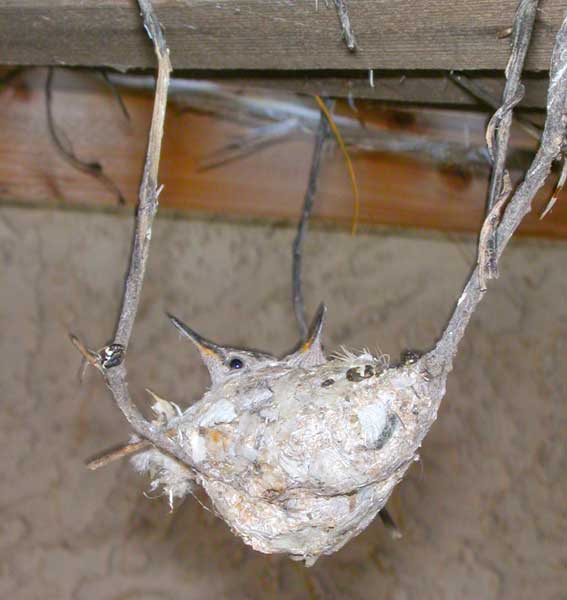

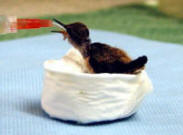 Hummingbirds need a special protein formula that researchers
have developed for our wildlife rehabilitators. Babies do
not survive on sugar water alone, which will result in
deformities and death. Sugar water will also get their
feathers sticky and damaged. The mother catches
hundreds of small insects to feed the babies as, like many
baby birds, they require lots of protein in their diet. The
young fledge in 18-29 days depending on species, food
supply, and weather conditions. They often sit on the side
of their nest for 2-3 days to exercise their wings before
fledging.
Hummingbirds need a special protein formula that researchers
have developed for our wildlife rehabilitators. Babies do
not survive on sugar water alone, which will result in
deformities and death. Sugar water will also get their
feathers sticky and damaged. The mother catches
hundreds of small insects to feed the babies as, like many
baby birds, they require lots of protein in their diet. The
young fledge in 18-29 days depending on species, food
supply, and weather conditions. They often sit on the side
of their nest for 2-3 days to exercise their wings before
fledging.
